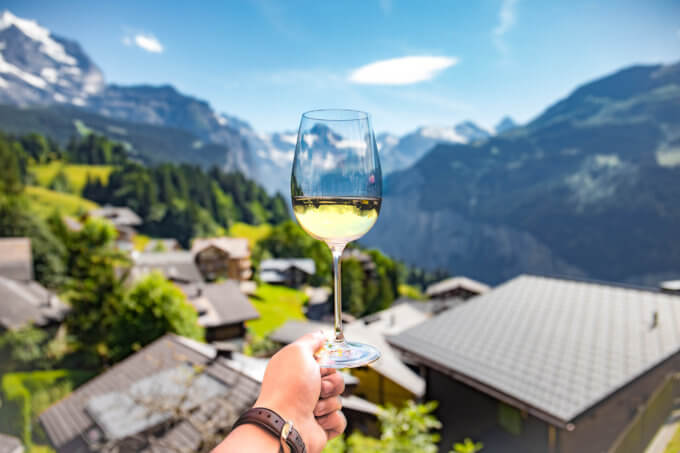Be social! Share the fun!
3 Exciting Strategies You'll Love to Sell Wine Online

Sell Wine Online - Gems from Central Coast Insights, Wine Business Monthly
Looking to sell wine online? Many of the strategies suggested by Wine Business Monthly’s Central Coast Insights webinar provide the model for success.
This post covers the most salient points of the panel discussion titled: “Experience and Ease in E-Commerce.”
You will also find the most important highlights of the retail keynote presentation, “The Rise of Off-Premise.”
These gems are just two of many substantial presentations in the Central Coast Insights webinar, which has applications to the entire industry.
Small Wineries: Tactics and Techniques to Sell Online

"Experience and Ease in E-Commerce Panel"- Wine Business Monthly Central Coast Insights
This lively panel, discussing how to sell wine online, featured three highly engaging speakers:
- Steve Tamburelli, co-founder, Vinitas Wine Group
- Luke Kohler, director of product, NakedWines.com
- Shannon Muracchioli, director of DTC and marketing, Clos Du Val Winery-
Until recently, most wineries didn’t think much about how to sell wine online.
With tasting rooms open, wine seemed to walk off tasting room shelves with minimal effort.
Now with COVID-19, wineries can no longer rely on people coming to visit them. Instead, they must learn to sell wine online.
One panelist framed the situation well in a quote from Winston Churchill: “Never Let a Good Crisis Go to Waste.”
Featured many times in Wine Business Monthly articles about virtual tastings, Shannon Muracchioli said that COVID-19 motivated people to “do things they knew they should have done” before the crisis.
Never Let a Good Crisis Go to Waste Click to Tweet
Luke Kohler reminded the audience that before COVID-19, many consumers did not even realize that it was possible to purchase wine online. So this is a great opportunity for wineries to reach these new consumers and sell wine online.
In New York City, a popular wine bar Compagnie des Vins Surnaturels sold their highly curated wine inventory to local consumers and via FedEx in a story via Forbes.

How to Sell Wine Online: Storytelling
Panelists discussed the importance of storytelling in digital marketing, and how it is crucial to take a consumer on a journey.
The “journey” should be as well-planned as it would be with a physical visit, translated to the digital world.
Using the phrase “plan your work, and work your plan,” Ms. Muracchioli explained that selling wine online is not a straight line. She spoke about developing a strategic format of building customer relationships online, just as one would in the physical world.
Sell Wine Online: Engagement Techniques

The panelists spoke extensively about how to engage with customers to get online wine sales. The important thing to remember, panelists underscored, is that “real people” are at the heart of every story.
This translates to getting the winemaking team involved with customer engagement. This can take place in an Instagram story, or even a #ThirstyThursday post.
In speaking of her own online wine sales experience at Clos du Val, Ms. Muracchioli spoke about the need to gather information about consumers to better relate to them.
“It wasn’t so long ago that winery personnel were happy with just an email address and a name,” she said. “Now it’s important to have a psychographic profile of the consumer to create a better emotional engagement.”
The panelists discussed the importance of the onboarding process, which represents the first step of the relationship they will develop over time with the winery.
This can take place in an Instagram story, or even a #ThirstyThursday post. Click to Tweet
Selling Wine Online: Engagement Techniques
As a group, the panelists encouraged winery personnel to test the onboarding as if an outsider. After signing up for the newsletter, winery personnel should purchase wine and take screenshots to document the experience.
Winery personnel should also test discount codes, as consumers often find this to be a particular glitch. Finally, winery personnel should document reception of the wine at their home. Is the wine and its packaging in good shape?
Ms. Muracchioli underscored that it is crucial to put effort into observing what happens after the customer receives the first order to ensure it is a positive and smooth experience. “This is especially important when competition builds and we are all operating in the same space.”
Online Wine Sales: The Importance of Branding
Luke Kohler spoke extensively on branding, especially to pay keen attention to winery logo and colors. “Consistency is key,” he said, reminding wineries that they should not put images on Facebook or Instagram without planning.
He also explained that it is important to make sure that if someone shares your brand on social media, they share it correctly.
While this can be hard to reinforce, as a journalist I interpreted this to mean that wineries should have a dedicated media page where the press can quickly go to grab a logo or winery-related photo, with the brand colors and typeface.
If someone shares your brand on social media, they must share it correctly. Click to Tweet
The Marketing Spend
Steve Tamburelli spoke about how historically small and midsize wineries failed to keep websites up to date or post tech sheets for new vintages. “As the industry moves forward, wineries have to look at the marketing spend and make sure they can do what they need to do to succeed,” he said.
The panelists mentioned the importance of monitoring the digital process and paying attention to Google Analytics, acquisition channels, and more. Facebook, they mentioned, has amazing tools, but one needs to understand how to use them to have success on that platform.
The panel also warned wineries to make online investment decisions based on data analysis, and not to jump into too many online platforms at once. It’s better, they advised, to master Instagram or Facebook ads before moving on to another social media platform.
The panel also underscored the importance of putting people in the right roles, and that small wineries should not try to do everything themselves. “The sooner you bring in the experts, the more it pays for itself,” was the general advice.
The sooner you bring in the experts, the more it pays for itself, Click to Tweet
A Look at Retail Sales
The COVID-19 situation is providing wineries with new and exciting ways to attract customers online.
The retail situation, especially in supermarkets, is also attracting new customers.
An unexpected benefit is that many of these consumers are millennial-aged.
As a few panelists explained, millennials are increasingly moving home with their parents and sharing family dinners where they experience wine for the first time.
Wine Business Monthly quoted John Gillespie, CEO of Wine Opinions, as saying “What I’m seeing is that millennials are really upping consumption, discovering wine, and having the experience of having wine as an everyday thing at home. I’m looking at that saying, ‘well, maybe this is the great awakening that we’ve all hoped would happen.’”
And remember the importance of packaging – another topic discussed at the WBM packaging conference.
The Rise of Off-Premise

One of the most refreshing highlights of this two-day conference was Mr. Markert’s dynamic presentation on the retail market.
As the director of liquor of Albertson’s Vons, and Pavilions (three of the premium supermarkets in California), Mr. Markert and his team have used the COVID-19 situation to revitalize the wine sections in all their supermarkets.
During his fast-paced, energetic presentation, Mr. Markert explained that the necessity of in-home dining and entertaining has spurred local consumers to explore the wine section.
He spoke at length about the need for a supermarket’s wine section to create an emotional connection with the consumer. To him this centers on its local history, and the local wineries which provide employment to the community.
In the Central Coast region of Paso Robles, for example, over 50% of all the wine sales are from the local wineries in the area (J. Lohr, Tablas Creek).
A supermarket’s wine section must create an emotional connection with the consumer. Click to Tweet
Imported Wine up in Supermarkets

Mr. Markert said that imported wine sales is up 40% since COVID-19, reflecting a large group of people reliving their memories of European travel by drinking imported wine at home.
In many of his stores, Mr. Markert has also created what he calls “AVA Sets”—these are wine sections organized by American Viticultural Areas (AVA). “Wine consumers are more educated today,” Mr. Markert said in his presentation, explaining how consumers locate their favorite wine in shops based on regions.
Phil Markert: What’s Selling Now
In his talk, Mr. Markert emphasized the growing importance of the “Healthier for You” section in his supermarkets, with consumers actively seeking lower calorie, lower carbohydrate, lower alcohol, and even no-alcohol wines. The dealcoholized wine Ariel is one of his top selling brands.
Phil Markert: Wine Education
Pre-COVID, “Beverage Stewards” in Mr. Markert’s stores enrolled in wine education programs and in-store classes. Now, with COVID-19, Mr. Markert says that he’s pivoted to virtual tastings which are more efficient for everyone involved.
Phil Markert: COVID-19 Creating More Wine-Focused Millennials
Just as John Gillespie told Wine Business Monthly, Mr. Markert sees sales of more expensive wine surge because of millennials moving back home and dining with their parents. These occasions are positively affecting sales, with his stores racing to increase their inventory of wines priced above $100.
Mr. Markert’s team showcase these luxury wines in special cellars, overseen by highly trained beverage stewards and sommeliers. One customer walked in and purchased over 47,000 dollars of wine in a single visit for his new home cellar.
Locally produced wines
Local wines from Central Coast regions are selling at a brisk clip. Virtually every store in a Central Coast region has its own display of local wine selections.
Project Cold
This is the term describing the chilled wine expansion in Mr. Marert’s supermarkets.
Drive Up and Go (DUG)
COVID-19 provided the impetus for this new section where shoppers place their wine order and easily drive up to collect it and go.
Phil Markert: Helping the Local Economy
Mr. Markert’s presentation provided a bird’s-eye view of the “gold coast” market, comprising some of the wealthiest wine-focused supermarket shoppers in California.
By focusing on wine education for his staff across all stores, creating programs like Drive Up and Go, and highlighting local wineries, Mr. Markert has helped his local economy and the stores under his jurisdiction.
Mr. Markert’s presentation provided a bird’s-eye view of the “gold coast” market Click to Tweet
If you own a smaller store, consider grouping wine in terms of “To Go” Food. This is what Tom Geniesse did for his standalone Bottle Rocket store in NYC.
As Forbes reports on its spotlight, Bottlerocket grouped different wines around Asian Takeout Food, Chinese Takeout food, and other popular take out categories due to increased takeout with COVID-19.
Final Thoughts on Wine Business Monthly Central Coast Insights Webinar Conference
This was an excellent view of every aspect of the Central Coast wine business, from supermarket retail chains to distribution, to restaurants and vineyard sales.
Marisa Dvari
– Subscribe to my newsletter to read and hear more about wine packaging trends in the wine world.